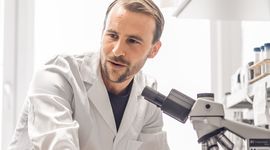Using special molecules to increase functional collagen 7 in RDEB skin cells
New scientific publication from the EB house
Recent breakthroughs in the treatment of recessive dystrophic Epidermolysis Bullosa (RDEB) have demonstrated significant potential through innovative gene therapies. These approaches involve either replacing or modifying the mutated collagen 7 gene in the skin cells. While these therapies hold promise for treating individual patients, the severity and diversity of disease symptoms underscores the importance to continuously explore alternative methods.
In a recent study, scientists from the EB House investigated the potential of splicing modulation as a treatment approach. Splicing is a crucial cellular process that removes non-essential sections from the gene transcript, forming a mature mRNA, which serves as template for protein production. In RDEB, genetic alterations in the collagen 7 gene can impede this process, resulting in defective or absent collagen 7 protein and severe skin blistering.
However, the researchers discovered that small amounts of the entire collagen 7 protein are produced in RDEB skin cells despite such a genetic variation. This suggests, that some correct splicing still occurs, providing an opportunity for artificial manipulation of the splicing process. Therefore, researchers explored the use of Antisense Oligonucleotides (ASOs) specifically designed to improve splicing of the collagen 7 gene. The ASO molecules alter the splicing process by binding to specific locations in the gene transcript. As a result, less faulty mRNA, and more correct mRNA is produced, ultimately leading to more functional collagen 7 protein in the cells.
Treatment of RDEB skin cells with a selected ASO showed increased production of the correct collagen 7 protein in these cells. The protein was also correctly deposited between the two skin layers, as demonstrated in a laboratory skin model system. This study shows the potential of ASOs for alleviating symptoms associated with RDEB. However, despite the encouraging results, further research is needed, particularly in creating models that accurately mimic the human situation. There are still additional challenges, such as the efficient delivery of ASOs through the skin and their optimization for better performance.
Please click here to access the article
